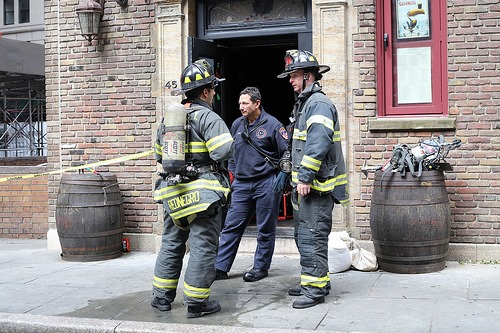Agency of Last Resort
When a series of tornados barreled through portions of Mississippi, Alabama, and Georgia in the spring of 2011, some citizens in Chickamauga, Georgia, found protection underneath their local fire departments’ rigs. At another fire station in western Alabama, local citizens found safe harbor in the basement of their local fire department. They weren’t alone.
According to a recent report from the U.S. Fire Administration (USFA), fire departments became the go-to institution citizens flocked to in that event.
“Throughout the region, citizens turned to their fire departments for assistance, guidance, and support,” the report stated. Whether local fire chiefs and firefighters like it or not, the local fire department has become the community’s resilient backbone.
“When nobody knew what else to do or where else to go to get help, they showed up at the fire stations. They showed up at firefighters’ homes,” says Cortez Lawrence, a USFA education specialist and the report’s principal investigator. When “things go to hell in a hand basket,” people turn to firefighters, he says.
This critical observation, according to Lawrence, led the USFA to make a very specific recommendation for all fire departments nationwide. “Fire departments must plan on becoming their communities’ ‘agency of last resort,’” the report states. “They need to know the county EOP [emergency operations plan], where resources are, where people and resources are to be collected, logistics distribution and support plans, special needs plans, and other information that people will congregate at the fire hall to gather.”
To achieve that objective, members of fire departments must be immersed in their communities’ disaster response and emergency management planning, says Lawrence.
In addition, fire departments and their first responders have to become jacks of all trades. They have to know who can call McDonald’s and order 500 hamburgers to feed homeless people and who has the authority to pay for it. They have to be trained to use hand pumps to get fuel if gas stations lose power. They have to know where to place a flatbed delivery of Porta Potties that arrives unexpectedly, a scenario that actually happened to one fire department after a tornado.
In addition, fire departments have to have a plan. If they don’t think they will be able to handle the influx of people seeking assistance, they should determine how they will outsource these duties to other local organizations. To the extent that they plan to handle these tasks, they also need to determine how they will do so without sacrificing their ability to meet their obligation to fight fires or mount search and rescue operations.
The most critical aspect of becoming the agency of last resort, however, is simply surviving whatever disaster has struck the department’s community. In Tuscaloosa, Alabama, for example, the city and county’s emergency operations center (EOC) became inoperable after its building was destroyed. Critical EOC communications were lost for hours as the city scrambled to get personnel out of the damaged facility and into another operational location.
To increase the odds of surviving any event, fire stations need to consider where they are located and the strength of their structure. For example, when possible, they should be built on high ground to protect against flooding.
One related concern to department survival when disaster strikes is ensuring that firefighters know that their family members are safe. It’s a lesson learned in New Orleans after the levees broke. “If your family’s missing, you’re not going to be available,” says Lawrence.
A solution for this is for firefighters to get their family members out of harm’s way in advance when there’s enough advanced notice.
The report was based on a series of meetings with 50 representatives from fire departments, emergency management agencies, and emergency medical services affected by the 2011 tornado outbreak. It notes that fire departments weren’t necessarily enthusiastic about the additional responsibilities.
Nevertheless, “while pressing the point that most were not prepared to do this kind of work and did not have the resources or training to handle the responsibility, in fact, every agency plans to continue in that role,” the report states.
Georgia Fire Academy Director David M. Wall says that firefighters accept that their communities already see them as de facto agencies of last resort, even if departments don’t train that way.
“When an issue arises of adults finding something in their life out of control, if it is not a crime or a pothole, they send the fire department,” he says. “And the fire department, regardless of budget cuts or volunteer roster size, will respond.”
Wall believes most fire departments are primed to take on the additional responsibilities associated with the agency-of-last-resort concept given that fire departments have already adopted an all-hazards approach to disasters and emergencies. That trend had been ongoing for the past few decades, but it went into overdrive after 9-11 raised the threat level.
Despite fire officials’ trepidations, there is at least one advantage to this mission creep: with the number and severity of most fire categories dropping, there is a risk of budgets being questioned and cut, says Lawrence, but the fire service will remain essential to public safety if its mission expands to accommodate this agency-of-last-resort concept.
